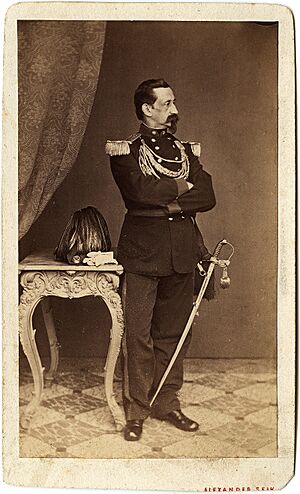Alexander Seik facts for kids
Alexander Seik (also known as Alex Sejk; born September 6, 1824 – died October 2, 1905) was a talented Czech photographer and painter. He also served as the mayor of Tábor, a city in the Czech Republic. Seik was a pioneer in Czech photography. He was especially known for his work with "chromophotography," a special way of making photos look three-dimensional.
Contents
The Life of Alexander Seik
How Alexander Seik Started Photography
Alexander Seik was born in Mirotice, a town near Písek, in what is now the Czech Republic. Like many early photographers, he first worked as a portrait painter. On June 1, 1855, he opened his own photography studio in Mladá Vožice. This made him one of the very first photographers in the Czech lands.
Seik's Popular Studio in Tábor
Later in 1855, Seik moved to Tábor. His photography studio quickly became very popular. It was located where the Hotel Palcát stands today. Most of his work involved taking portraits. These were often in the "Carte de visite" format. This was a small photograph, like a calling card.
Seik also tried taking photos outdoors. This was very difficult back then! In 1860, he sold a photograph of Tábor to the town itself. It cost 26 gold pieces. This was about a teacher's monthly salary at the time. People from many towns came to Seik's studio. Even towns that had their own photographers. The oldest known photos by Seik are from 1858. They are hand-colored and show the parents of August Sedláček. You can find them in the Práchenské muzeum in Písek.
In 1865, Seik opened a new, more modern studio. But after two months, he found it didn't have enough light. So, he decided to fix up and reopen his original studio.
International Fame for Seik's Photos
Seik's studio became famous around the world in 1866. This was during the Prussian invasion of Bohemia. Many Prussian soldiers chose to have their pictures taken by Seik. They then sent these portraits home. People said Seik's photos were better than those in Berlin. Some of these soldier portraits are still kept today. You can see them at the Hussite Museum in Tábor.
Seik's Photography Inventions
Seik often talked about his many photography inventions. Sadly, the details of these inventions are not fully known today. He was very interested in chromophotography. This was a special portrait technique. It made photos look like they had a three-dimensional effect. Only a few photographers mastered this method. It was a special skill in Central Europe.
A newspaper in Tábor wrote about Seik in 1865. It mentioned that he had improved the chromophotography technique. Another article in 1869, by Jakub Husník, said Seik had improved photography onto porcelain.
Seik's Role in Town Life
Seik became more and more involved in the social life of Tábor. In 1869, he joined the Sharpshooters Company. He later became its commander in 1883. He created a special album for the club. It had portraits of all its members. This album is the largest collection of Seik's work known today. In 1872, he joined the Photographic Society of Vienna.
Seik also entered politics. He became a member of the Town Council of Tábor in 1870. In 1873, he joined the Executive Council. He was in charge of the Police department.
Partnership and Politics
In 1878, the newspaper Český jih announced a new partnership. It was between Alexander Seik and Ignác Šechtl. Some photos from this time show both their names. Others show only one name. However, Seik started to lose interest in photography. He was focusing more on politics. So, around 1886, their partnership ended.
Alexander Seik as Mayor of Tábor
Seik became the Mayor of Tábor in 1889. He held this important position for 10 years. During his time as mayor, Tábor grew and developed a lot. For example, the Church of the Transfiguration was rebuilt. The Bechyně Gate was also rebuilt. New buildings like the Shooting Gallery Community Centre and the Tobacco factory were constructed. Tábor also became a very important railway center during this time.
When Seik passed away, the local newspaper wrote a long obituary. It thanked him for all his hard work for Tábor. It said his efforts had brought new glory to the city.


